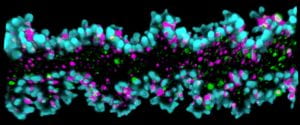Presbyopia is the progressive loss of ability to focus on near objects and thus the need for reading glasses. In the young eye, the lens is flat to focus on objects in the distance. During accommodation, the lens become more spherical to allow focusing on a near object. As the lens ages, it is no longer able to change shape to allow focusing on near objects. It is hypothesized that decreased lens elasticity and increased lens size and stiffness with age contribute to the development of presbyopia. The molecular and cellular mechanisms that control lifelong lens growth and stiffness remain unclear. There are currently no treatments to delay the onset of presbyopia.

Our lab used a simple compression method to show that mouse lenses stiffen with age, similar to human lenses. This suggests that mouse genetic models may be used to better understand the mechanisms required for human lens mechanical integrity and age-related pathologies. We are collecting data to mathematically model lens biomechanical properties during shape change.
It had long been hypothesized that the elaborate morphology of lens fiber cells supported its biomechanical function to flatten and relax during accommodation. Lens fiber cells have complex interdigitations to form a 3-dimensional zipper between neighboring cells. We created a new method to immunostain single lens fiber cells and coupled that with super-resolution microscopy to study the proteins need for formation of complex fiber cell interdigitations required for lens biomechanical integrity. Our recent work revealed that membrane interdigitations are crucial for lens biomechanical properties.
We are currently investigating the link between the stiff core of the lens (the lens nucleus) and overall mechanical properties of the lens. Contrary to long-held theories, our results suggest that the size of the lens nucleus does not impact the overall stiffness of the lens. By understanding the cellular and morphological features of lens cells that are required for lens biomechanical properties, we can better design treatments to help the lens retain its accommodative ability.
